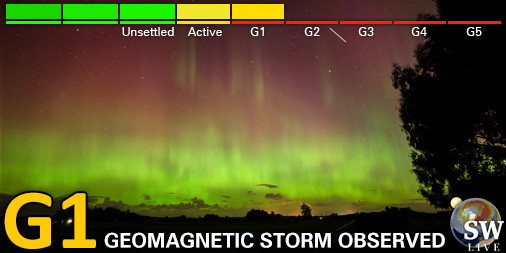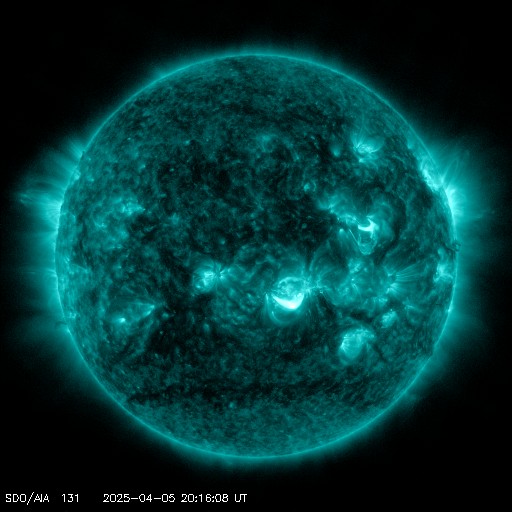Viewing archive of Monday, 24 October 2016
Daily bulletin on solar and geomagnetic activity from the SIDC
Issued: 2016 Oct 24 1231 UTC
SIDC Forecast
Solar flares
Quiet conditions (<50% probability of C-class flares)
Geomagnetism
Major magstorm expected (A>=50 or K>=6)
Solar protons
Quiet
| 10cm flux | Ap | |
|---|---|---|
| 24 Oct 2016 | 076 | 011 |
| 25 Oct 2016 | 076 | 045 |
| 26 Oct 2016 | 076 | 050 |
Bulletin
Solar activity was very low, with no x-ray flaring observed. The sole sunspot region that is currently visible, NOAA 2603, is small and decaying. No earth-directed coronal mass ejections (CMEs) were observed.
Solar flare activity is expected to remain below the C-class level.
Solar wind speed decreased from about 440 km/s to its current values near 380 km/s. Bz fluctuated between -8 nT and +6 nT, and was mostly negative. Quiet to unsettled geomagnetic conditions were observed, with an isolated active episode near midnight. The interplanetary magnetic field was mostly directed away from the Sun (positive). A huge, positive, recurrent coronal home (CH) is transiting the central meridian.
Mostly quiet to unsettled geomagnetic conditions are expected until the arrival of the co-rotating interaction region (CIR) preceding the high speed stream (HSS) from the aforementioned CH. This arrival is currently foreseen for 25 October, with minor geomagnetic storming possible from then onwards. There's a good chance on an isolated moderate storm interval (K-index = 6).
Today's estimated international sunspot number (ISN): 015, based on 04 stations.Solar indices for 23 Oct 2016
| Wolf number Catania | /// |
| 10cm solar flux | 077 |
| AK Chambon La Forêt | /// |
| AK Wingst | 011 |
| Estimated Ap | 010 |
| Estimated international sunspot number | 016 - Based on 17 stations |
Noticeable events summary
| Day | Begin | Max | End | Loc | Strength | OP | 10cm | Catania/NOAA | Radio burst types | |
|---|---|---|---|---|---|---|---|---|---|---|
| None | ||||||||||
Provided by the Solar Influences Data analysis Center© - SIDC - Processed by SpaceWeatherLive
All times in UTC
Current data suggests there is a moderate possibility for aurora to appear at the following high latitude regions in the near future
Norilsk, VorkutaCurrent data suggests there is a slight possibility for aurora to appear at the following high latitude regions in the near future
ArkhangelskCurrent data suggests there is a slight possibility for aurora to appear at the following middle latitude regions in the near future
Surgut, SyktyvkarLatest news
Latest forum messages
Support SpaceWeatherLive.com!
A lot of people come to SpaceWeatherLive to follow the Sun's activity or if there is aurora to be seen, but with more traffic comes higher server costs. Consider a donation if you enjoy SpaceWeatherLive so we can keep the website online!

Latest alerts
17:33 UTC - Hemispheric Power Index
The OVATION model predicts the Hemispheric Power Index to reach 51GW at 18:18 UTC
Sunday, 6 April 2025
02:00 UTC - Geomagnetic activity
Minor G1 geomagnetic storm (Kp5) Threshold Reached: 01:50 UTC
Saturday, 5 April 2025
20:30 UTC - Geomagnetic activity
Minor G1 geomagnetic storm (Kp5) Threshold Reached: 20:20 UTC
20:24 UTC - Solar flare
Moderate M1.05 flare
20:09 UTC - Radio Blackout
Minor R1 radio blackout in progress (≥M1 - current: M1.05)
Space weather facts
| Last X-flare | 2025/03/28 | X1.1 |
| Last M-flare | 2025/04/05 | M1.0 |
| Last geomagnetic storm | 2025/04/06 | Kp5 (G1) |
| Spotless days | |
|---|---|
| Last spotless day | 2022/06/08 |
| Monthly mean Sunspot Number | |
|---|---|
| March 2025 | 134.2 -20.4 |
| April 2025 | 148.7 +14.5 |
| Last 30 days | 132.7 -9.9 |





